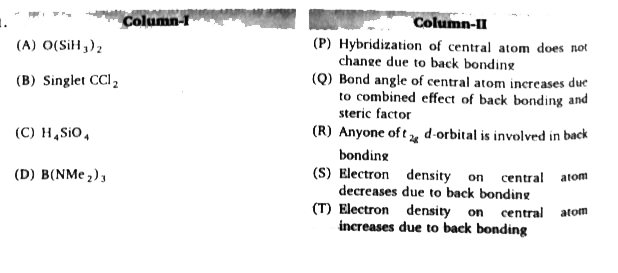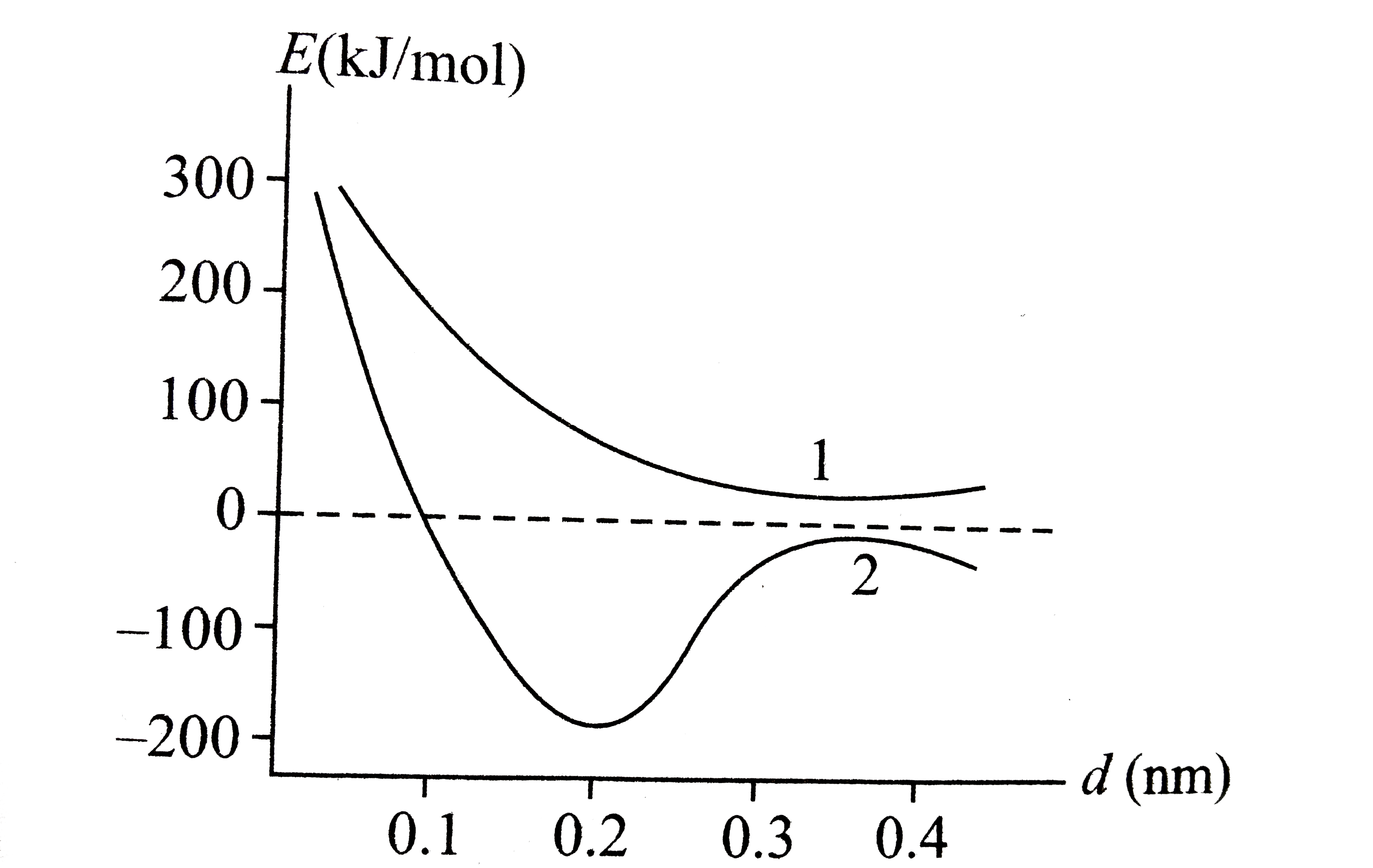According to MOT, two atomic orbitals overlap resulting in the formation of molecular orbital formed. Number of atomic orbitals overlapping together is equal to the molecule orbital formed. The two atomic orbital thus formed by LCAO (linear combination of atomic orbital) in the phase or in the different phase are known as bonding and antibonding molecular orbitals respectively. The energy of bonding molecular orbital is lower than that of the pure atomic orbitals by an amount Δ. This known as the stabilization energy. The enerby of antibonding molecular orbital in increased by Δ' (destabilisation energy).
Q. which of the following combination of orbitals is corrects?




The correct Answer is:C
To solve the question regarding the correct combination of orbitals based on Molecular Orbital Theory (MOT), we will analyze each option provided and determine whether the interactions lead to constructive or destructive interference.
1. Understanding Orbital Interactions:
- When two atomic orbitals overlap, they can either be in the same phase (constructive interference) or in opposite phases (destructive interference).
- Constructive interference occurs when lobes of similar phase overlap, resulting in increased electron density, which leads to the formation of a bonding molecular orbital.
- Destructive interference occurs when lobes of opposite phase overlap, resulting in decreased electron density, leading to the formation of an antibonding molecular orbital.
2. Analyzing Each Option:
- Option A: This option shows a negative phase interacting with a positive phase. This indicates destructive interference, which means the electron density should decrease. However, if the electron density is increasing, this option is incorrect.
- Option B: Here, two negative phases are interacting. This indicates constructive interference, which means the electron density should increase. If the electron density is actually decreasing, this option is also incorrect.
- Option C: In this option, a negative phase interacts with a positive phase, indicating destructive interference. If the electron density is indeed decreasing, this option is correct.
- Option D: This option shows a negative sign between the lobes. If we assume the signs are reversed, we have a positive phase interacting with a negative phase, indicating destructive interference. If the electron density is increasing, this option is incorrect.
3. Conclusion:
- After analyzing all options, we find that Option C is the correct combination of orbitals where the negative phase interacts with the positive phase, leading to destructive interference and a decrease in electron density.
Final Answer:
The correct combination of orbitals is Option C.
- When two atomic orbitals overlap, they can either be in the same phase (constructive interference) or in opposite phases (destructive interference).
- Constructive interference occurs when lobes of similar phase overlap, resulting in increased electron density, which leads to the formation of a bonding molecular orbital.
- Destructive interference occurs when lobes of opposite phase overlap, resulting in decreased electron density, leading to the formation of an antibonding molecular orbital.
- Option A: This option shows a negative phase interacting with a positive phase. This indicates destructive interference, which means the electron density should decrease. However, if the electron density is increasing, this option is incorrect.
- Option B: Here, two negative phases are interacting. This indicates constructive interference, which means the electron density should increase. If the electron density is actually decreasing, this option is also incorrect.
- After analyzing all options, we find that Option C is the correct combination of orbitals where the negative phase interacts with the positive phase, leading to destructive interference and a decrease in electron density.
The correct combination of orbitals is Option C.
Topper's Solved these Questions
- BOOK - VK JAISWALCHAPTER - CHEMICAL BONDING (ADVANCED)EXERCISE - ONE OR MORE ANSWER IS/ARE CORRECT84videos
CHEMICAL BONDING (ADVANCED)
- BOOK - VK JAISWALCHAPTER - CHEMICAL BONDING (ADVANCED)EXERCISE - MATCH THE COLUMN26videos
CHEMICAL BONDING (ADVANCED)
- BOOK - VK JAISWALCHAPTER - CHEMICAL BONDING (ADVANCED)EXERCISE - Level 2156videos
CHEMICAL BONDING (ADVANCED)
- BOOK - VK JAISWALCHAPTER - CHEMICAL BONDING (BASIC)EXERCISE - Level 3 (Passive 11)6videos
CHEMICAL BONDING (BASIC)
Similar Questions
Which is correct statement ?
05:55View SolutionColumn-I and Column-II contains four entries each. Entries of Column -I are to be matched with some entries of Column-II. One or more than one entries of Column-I may have the matching with the same entries of Column-II.
 11:29View Solution
11:29View SolutionConsider the given figure showing the formation of H+2 ion depending on intermuclear distance versus potential energy of the system.
 07:21View Solution
07:21View SolutionConsider the following elements with their period number and valence electrons.
ElementsPeriod numberTotal valencee−P24Q26R37S33T36U34
According to the given informations, answer the following questions :
Choose incorrect statement :04:48View SolutionAccording to MOT, two atomic orbitals overlap resulting in the formation of molecular orbital formed. Number of atomic orbitals overlapping together is equal to the molecule orbital formed. The two atomic orbital thus formed by LCAO (linear combination of atomic orbital) in the phase or in the different phase are known as bonding and antibonding molecular orbitals respectively. The energy of bonding molecular orbital is lower than that of the pure atomic orbitals by an amount Δ. This known as the stabilization energy. The enerby of antibonding molecular orbital in increased by Δ' (destabilisation energy).
Q . The bond order of N−2 is equal to that of07:25View SolutionAccording to MOT, two atomic orbitals overlap resulting in the formation of molecular orbital formed. Number of atomic orbitals overlapping together is equal to the molecule orbital formed. The two atomic orbital thus formed by LCAO (linear combination of atomic orbital) in the phase or in the different phase are known as bonding and antibonding molecular orbitals respectively. The energy of bonding molecular orbital is lower than that of the pure atomic orbitals by an amount Δ. This known as the stabilization energy. The enerby of antibonding molecular orbital in increased by Δ' (destabilisation energy).
Q. Which among the following pairs contains both paramagnetic species.03:49View SolutionAccording to MOT, two atomic orbitals overlap resulting in the formation of molecular orbital formed. Number of atomic orbitals overlapping together is equal to the molecule orbital formed. The two atomic orbital thus formed by LCAO (linear combination of atomic orbital) in the phase or in the different phase are known as bonding and antibonding molecular orbitals respectively. The energy of bonding molecular orbital is lower than that of the pure atomic orbitals by an amount Δ. This known as the stabilization energy. The enerby of antibonding molecular orbital in increased by Δ' (destabilisation energy).
Q. Which of the following statement(s) is true:10:15View SolutionAccording to MOT, two atomic orbitals overlap resulting in the formation of molecular orbital formed. Number of atomic orbitals overlapping together is equal to the molecule orbital formed. The two atomic orbital thus formed by LCAO (linear combination of atomic orbital) in the phase or in the different phase are known as bonding and antibonding molecular orbitals respectively. The energy of bonding molecular orbital is lower than that of the pure atomic orbitals by an amount Delta . This known as the stabilization energy. The enerby of antibonding molecular orbital in increased by Delta' (destabilisation energy). Q. Which of the following pairs of molecule can exist?
11:29View SolutionAccording to MOT, two atomic orbitals overlap resulting in the formation of molecular orbital formed. Number of atomic orbitals overlapping together is equal to the molecule orbital formed. The two atomic orbital thus formed by LCAO (linear combination of atomic orbital) in the phase or in the different phase are known as bonding and antibonding molecular orbitals respectively. The energy of bonding molecular orbital is lower than that of the pure atomic orbitals by an amount Δ. This known as the stabilization energy. The enerby of antibonding molecular orbital in increased by Δ' (destabilisation energy).
Q. How many nodal plane is present in σsandp bonding molecular orbital ?View SolutionAccording to MOT, two atomic orbitals overlap resulting in the formation of molecular orbital formed. Number of atomic orbitals overlapping together is equal to the molecule orbital formed. The two atomic orbital thus formed by LCAO (linear combination of atomic orbital) in the phase or in the different phase are known as bonding and antibonding molecular orbitals respectively. The energy of bonding molecular orbital is lower than that of the pure atomic orbitals by an amount Delta . This known as the stabilization energy. The enerby of antibonding molecular orbital in increased by Delta' (destabilisation energy). Q. Which of the following statements is not correct regarding bonding molecular orbitals?
02:38View SolutionAccording to MOT, two atomic orbitals overlap resulting in the formation of molecular orbital formed. Number of atomic orbitals overlapping together is equal to the molecule orbital formed. The two atomic orbital thus formed by LCAO (linear combination of atomic orbital) in the phase or in the different phase are known as bonding and antibonding molecular orbitals respectively. The energy of bonding molecular orbital is lower than that of the pure atomic orbitals by an amount Δ. This known as the stabilization energy. The enerby of antibonding molecular orbital in increased by Δ' (destabilisation energy).
Q. If x-axis is the molecular axis, then π-moleulcar orbitals are formed by the overlap of :03:07View SolutionAccording to MOT, two atomic orbitals overlap resulting in the formation of molecular orbital formed. Number of atomic orbitals overlapping together is equal to the molecule orbital formed. The two atomic orbital thus formed by LCAO (linear combination of atomic orbital) in the phase or in the different phase are known as bonding and antibonding molecular orbitals respectively. The energy of bonding molecular orbital is lower than that of the pure atomic orbitals by an amount Δ. This known as the stabilization energy. The enerby of antibonding molecular orbital in increased by Δ' (destabilisation energy).
Q. Which among the following pairs contains both paramagnetic species.01:36View SolutionAccording to MOT, two atomic orbitals overlap resulting in the formation of molecular orbital formed. Number of atomic orbitals overlapping together is equal to the molecule orbital formed. The two atomic orbital thus formed by LCAO (linear combination of atomic orbital) in the phase or in the different phase are known as bonding and antibonding molecular orbitals respectively. The energy of bonding molecular orbital is lower than that of the pure atomic orbitals by an amount Delta . This known as the stabilization energy. The enerby of antibonding molecular orbital in increased by Delta' (destabilisation energy). Q. If x-axis is the molecular axis, then pi -moleulcar orbitals are formed by the overlap of :
02:30View SolutionAccording to MOT, two atomic orbitals overlap resulting in the formation of molecular orbital formed. Number of atomic orbitals overlapping together is equal to the molecule orbital formed. The two atomic orbital thus formed by LCAO (linear combination of atomic orbital) in the phase or in the different phase are known as bonding and antibonding molecular orbitals respectively. The energy of bonding molecular orbital is lower than that of the pure atomic orbitals by an amount Δ. This known as the stabilization energy. The enerby of antibonding molecular orbital in increased by Δ' (destabilisation energy).
Q . The bond order of N−2 is equal to that of03:03View SolutionAccording to MOT, two atomic orbitals overlap resulting in the formation of molecular orbital formed. Number of atomic orbitals overlapping together is equal to the molecule orbital formed. The two atomic orbital thus formed by LCAO (linear combination of atomic orbital) in the phase or in the different phase are known as bonding and antibonding molecular orbitals respectively. The energy of bonding molecular orbital is lower than that of the pure atomic orbitals by an amount Delta . This known as the stabilization energy. The enerby of antibonding molecular orbital in increased by Delta' (destabilisation energy). Q. Which of the following statement(s) is true:
03:29View Solution

